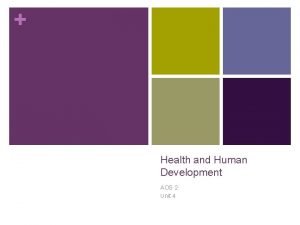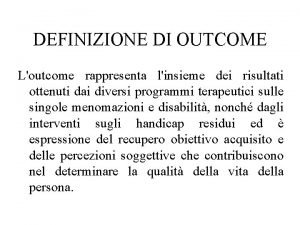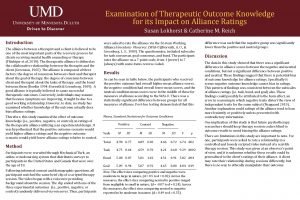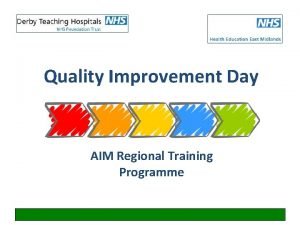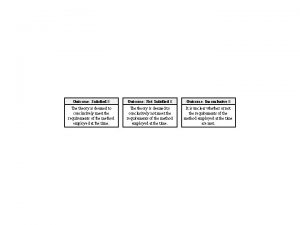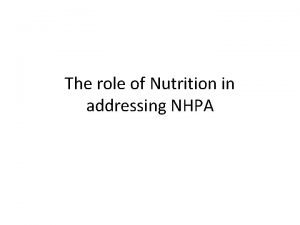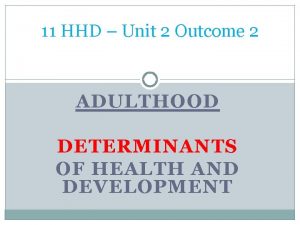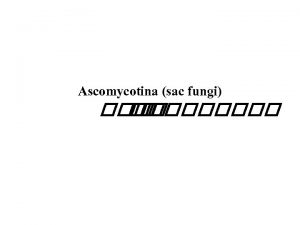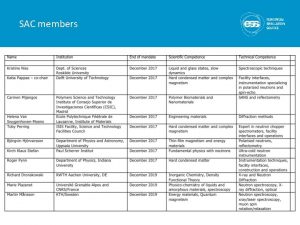HHD SAC 2 2016 Outcome 1 NHPA n





















- Slides: 21

+ HHD SAC 2 2016 Outcome 1

+ NHPA n List the 9 NHPA’s

+ Costs n Diabetes Mellitus is a major burden of disease to the Australian Health Care System. n List one cost to the individual of DM. n List one cost to the community of DM n List one intangible cost of DM

+ Sodium n What is Sodium. n Name two foods sodium is found in. n Sodium is a risk factor for which NHPA n Describe risk factors of having too much sodium in the diet.

+ Protein n Name four major food sources of protein. n Why does the body need protein?

+ Dementia n Describe Dementia. n Why was Dementia included as a NHPA?

+ Obesity n How is obesity defined? n Give two indicators of obesity.

+ Programs to address NHPAs n Name a program that can address diet related NHPAs and then describe this program.

+ Programs to Use n Possible examples could include: n A healthy and active Australia n Get Set for Life n Healthy Spaces and Places n Live Lighter n No longer current n Go for 2 and 5 program n Shape up Australia n Swap it Don’t Swap it

+ Risk and Protective Factors Outline the role that fibre plays in relation to CVD List three major food sources of fibre Outline the role saturated and/or trans fats play in relation to cardiovascular disease. List three major food sources of trans fats and saturated fats

+ Live Lighter Program n This program was developed by the WA Department of Health and implemented in Victoria in 2014. Its aims are to assist people to eat a healthy diet, exercise and therefore maintain a healthy body weight. It includes graphic advertising campaigns targeted at adults to educate them about the dangers of obesity and abdominal fat, with a focus on the relationship between being overweight and diseases such as heart disease, type 2 diabetes and cancer. The Live. Lighter website also includes a range of resources that are designed to support individuals in making behaviour changes by providing a 12 week meal and activity planner, healthy recipes and an assessment tool. The website also provides a series of tips that gives practical advice on how to make changes to food intake and become more physically active.

+ Cardiovascular Health n Justify why the government would invest in developing and implementing a health promotion program aimed at addressing the NHPA of Cardiovascular Health.

+ CVD n Cardiovascular disease contributes significantly to the burden of disease in Australia and accounts for the highest number of deaths. Investing in a health promotion campaign may reduce the disease burden and the overall direct, indirect and intangible costs associated with the disease. n Cardiovascular disease is preventable as many of the determinants can be modified with changes to lifestyle. Health promotion campaigns work to bring about changes to behaviour which will reduce the burden of disease and the overall costs to the health care system. n Cardiovascular disease contributes significant costs to the health care system so bringing about changes in behaviour that will reduce the burden of disease will save the government money.

+ Diabetes Mellitus n Describe Diabetes Mellitus n List three types of Diabetes Mellitus n Outline the differences between Type 1 and Type 2 Diabetes n Why has Diabetes Mellitus been included in the NHPAs? n Identify one example of a social determinant that acts as a risk factor for type 2 diabetes and explain why it is a risk factor. n 2 marks

+ Social Determinant n Examples could include: n Socio-economic status: people with low socio-economic status tend to have higher levels of obesity which is a risk factor for type 2 diabetes. n Occupation: people who work in sedentary occupations which require little energy expenditure could be at greater risk of becoming overweight or obese which is a risk factor for type 2 diabetes. n Food Security: people who lack food security are more likely to eat a diet that is energy dense and includes processed foods that can increase the risk of becoming overweight or obese which increases the risk of developing type 2 diabetes. n Early life experiences: low birth weight is associated with an increased risk of developing type 2 diabetes later in life.

+ Diabetes Mellitus n Type 1 diabetes is an auto immune disease that often occurs when a person is young and often after an illness. It results in the pancreas being unable to produce insulin which is needed for the blood sugar to be moved into the cells to be used for energy. Type 1 diabetes is unable to be prevented. n Type 2 diabetes on the other hand can often be prevented. It usually occurs during adulthood and is the result of lifestyle factors that have contributed to an individual being overweight or obese. The pancreas is unable to produce enough insulin or the insulin that is produced is unable to be used by the body. Type 2 diabetes can often be managed by modifying lifestyle factors such as diet and exercise.

+ Injury prevention and Control n Describe the NHPA, Injury, Prevention and Control. n List one biological and one behavioural determinant of health and outline why it is a risk factor in this NHPA. n Describe and outline a health promotion program to address this NHPA.

+ Biological Determinants n Age: Children are often at high risk of injuries from falls due to their physical development. An infant’s head is proportionally much larger and heavier and as a result they are at risk of falling down stairs or falling over and injuring themselves. n • Age: Older people are more at risk of falling as their body is generally not as strong as it previously has been and they can feel more unsteady on their feet. As bones become older they also become more brittle and can break more easily as a result of a fall. n • Body proportions: Children’s body proportions places them at greater risk of injuries due to falls. An infant and toddler has a proportionally larger head in relation to the rest of their body which makes them top heavy and at greater risk of toppling over.

+ Injury Prevention and Control Health promotion program: Victoria’s Road Safety Strategy n Vic. Roads in collaboration with the Victoria Police, TAC and the Department of Justice developed a strategy to reduce the burden of disease associated with road trauma. It focuses on three main areas that include engineering, education and enforcement. Funding is provided to improve roads and road sides so the roads are safer. There is also a focus on education which teaches people how to be safe drivers with a range of radio and television campaigns, particularly in relation to the need to avoid distractions whilst driving. The third element of the program has a focus on enforcement where stronger penalties have been introduced for traffic infringements and for driving under the influence of drugs and alcohol. Increased presence of the police on the roads is also designed to catch people who text when driving and there has been an increase in drug testing by police.

+ Colorectal Cancer n What is colorectal cancer? n Discuss the role of nutrition as a protective factor for colorectal cancer. n Discuss the diet needed to address the occurance of colorectal cancer. n What is a program that can be used to promote good health for colorectal cancer?

+ Colorectal Cancer n A diet high in fibre is a protective factor for colorectal cancer. With fibre in the diet, a person is less likely to suffer from constipation which slows down the movement of waste through the large intestine. Constipation leaves the lining of the large intestine exposed to waste products for longer which can increase the risk of developing colorectal cancer. n • Consuming a nutrient dense rather than an energy dense diet high in fat and simple carbohydrates is a protective factor for colorectal cancer. A nutrient dense diet generally contains less kilojoules which decreases the risks associated with becoming obese. Obesity is a risk factor for the colorectal cancer. n • Drinking plenty of water each day helps protect against colorectal cancer as water assists in keeping the stools soft and easier to pass and therefore avoids constipation. This reduces the length of time faeces are in the bowel and reduces the risk of colorectal cancer
 Lesser sac vs greater sac
Lesser sac vs greater sac Ligament of stomach
Ligament of stomach Greater and lesser sac of peritoneum
Greater and lesser sac of peritoneum What is peritoneal cavity
What is peritoneal cavity Hhd vcaa
Hhd vcaa Health and human development unit 4 aos 2
Health and human development unit 4 aos 2 Ancient egypt and judaism outcome the new kingdom
Ancient egypt and judaism outcome the new kingdom Outcome based assessment in ecd
Outcome based assessment in ecd Outcome clinico significato
Outcome clinico significato Outcome program kotaku
Outcome program kotaku Required outcome
Required outcome Therapeutic outcome study
Therapeutic outcome study Child outcome rating scale
Child outcome rating scale Input outcome output impact chain
Input outcome output impact chain Intended outcome
Intended outcome Satisfied outcome
Satisfied outcome Pediatric physical therapy assessment tools
Pediatric physical therapy assessment tools United states v. nixon significance
United states v. nixon significance Experimental outcomes
Experimental outcomes Learning objectives of a poem
Learning objectives of a poem The renaissance outcome the renaissance in italy
The renaissance outcome the renaissance in italy Cold war outcome
Cold war outcome





